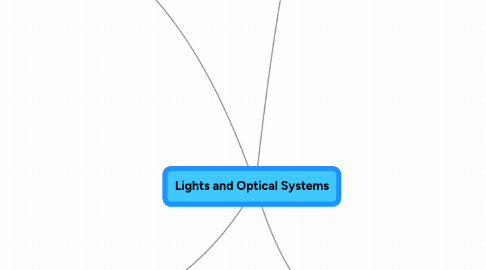
1. Our knowledge about light and vision comes from explanations, inventions, and investigations.
1.1. 1.1 The Challenges of Light
1.2. 1.2 Optical Devices
1.2.1. Optical Device:any device that uses light.
1.2.2. Telescope:optical device for veiwing distant objects.
1.2.3. Refractig Telescopes: telescope that uses lenses.
1.2.4. Reflecting Telescopes: telescope that uses lenses and mirrors.
2. Light is a part of the electromagnetic spectrum.
2.1. 3.1 The Wave Model of Light
2.1.1. Wave Model of Light: model used to describe the characteristics of light.
2.2. 3.2 The Elactromagnetic Spectrum
2.2.1. Radio Waves:electromagnetic radiation used for communication.
2.2.2. Microwaves:electromagnetic radiation used to cook food.
2.2.3. Infared Waves: electromagnetic waves that are invisible but can be felt as heat.
2.2.4. UV Light: electromagnetic radiation that can cuse skin cancer.
2.2.5. X Rays:electromagnetic radiation used to see inside a human body.
2.2.6. Gamma Rays: electroagnetic radiation used to cure cancer.
2.2.7. Electromagnetic Radiation:all forms of radiant energy.
2.2.8. Electromagnetic Spectrum: refers to whole range of wavelengths.
2.2.9. Radar: radio detecion and ranging.
2.2.10. Invisible Spectrum: parts of the spectrum humans can't see.
2.3. 3.3 Producing Visible Light
2.3.1. Incadescent: form of artificial light that uses electricity.
2.3.2. Flourescent:form of artificial that uses UV light.
2.3.3. Phosphor: substance that emits light.
2.3.4. Phosphorescence: process where a substance emits light.
2.3.5. Bioluminescence:the ability of organisms to create light.
2.3.6. Photophore:light producing organ.
2.4. 3.4 The Colours of Light
2.4.1. Primary Colours:red, green, and blue light.
2.4.2. Secondary Colour:yellow, cyan, and magenta.
2.4.3. Theory of Colour Addition: theory of what happens when colored lights are mixed together.
3. Light behaves in predictable ways.
3.1. 2.1 Light Travels in Rays and Interacts with Materials
3.1.1. Ray Diagrams: diagram that shows how light travels.
3.1.2. Intensity:brightness of light.
3.1.3. Transparent:materials that let light pass through without reflection.
3.1.4. Translucent:materials that let some light through.
3.1.5. Opaque:materials that let no light through.
3.1.6. Non-Luminous:objects that don't produce light.
3.1.7. Luminous:materials that produce light.
3.1.8. Regular Recflection: reflection when light hits a smooth surface.
3.1.9. Diffuse Reflection:reflection when light hits a rough surface.
3.2. 2.2 The Law of Reflection:
3.2.1. Plane Mirrors:flat mirror.
3.2.2. Incident Rays:ray of light that arrives at a mirror.
3.2.3. Normal:line perpindicular to surface.
3.2.4. Angle of Incidence: angle between incident ray and normal.
3.2.5. Angle of Reflection:angle between reflected ray and normal.
3.2.6. Law of Reflection: angle of incidence=angle of reflection.
3.3. 2.3 Reflecting Lighit with Curved Mirrors
3.3.1. Focal Point:point where light rays meet.
3.3.2. Concave Mirror:reflecting surface curved inward.
3.3.3. Convex Mirror:reflecting surface that bulges out.
3.4. 2.4 Transparent Substances Refract Light
3.4.1. Refraction:bending of light.
3.5. 2.5 Lenses Refract and Focus Light
3.5.1. Lens:curved peice of glass.
3.5.2. Convex Lens:transparent material that bulges outwards.
3.5.3. Real Image:image formed when rays meet.
3.5.4. Concave Lens:peice of trnsparent material curved inwards.
4. Eyes and cameras capture images using the properties of light.
4.1. 4.1 Image Formation in Eyes and Cameras
4.1.1. Pupil:opening in eye that lets in light.
4.1.2. Apeture:hole in camera that lets in light.
4.1.3. Iris:band of muscle that lets in light.
4.1.4. Diaphragm: part of camera that changes apeture size.
4.1.5. Shutter:part that acts as a door on a camera.
4.1.6. Retina:special lining at the back of the eye.
4.1.7. Photoreceptors: light sensitive cells in the eyes.
4.1.8. Rods:parts in nthe eye that are sensitive to light.
4.1.9. Cones:cells in the eye that detect colour.
4.1.10. Optic Nerve:nerve that leads from the retina to the brain.
4.1.11. Film: material sensitive to light.
4.2. 4.2 Other Eyes in the Animal Kingdom
4.2.1. Nocturnal:animals active at night.
4.2.2. Ommatidium: unit of a compound eye.
4.2.3. Compound Eye: eyes made up of smaller units.
4.3. 4.3 Image Storage and Transmission
4.3.1. Digital Imaging: process of creating an image with a computer.
4.3.2. Pixels:picture element
4.3.3. Charge Coupled Device:device that converts light into electricity.
